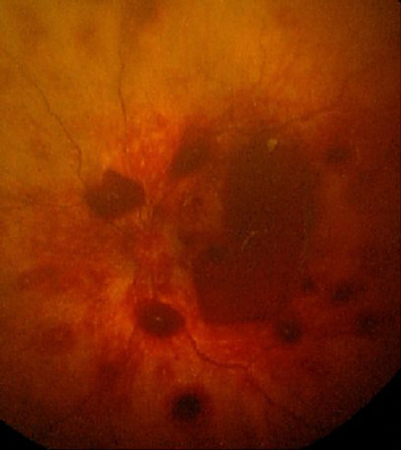History and exam
Key diagnostic factors
common
presence of risk factors
Key risk factors include: age <1 year, peak of normal crying curve, and presence of a male carer.
age <3 years
The incidence of abusive head injury in children is highest in infancy and occurs less frequently in children age >3 years.[13]
altered mental status: irritability/lethargy/coma
Neurological sign indicative of brain injury. Clinically suggests raised intracranial pressure.
clinical findings inconsistent with carer history
The carer's history is generally inconsistent with the medical findings. It is common for carers to offer either no history of trauma or a history of minor trauma that in no way could lead to scalp or skull injury or the degree of brain injury that is present.[35]
retinal/vitreal haemorrhages or retinoschisis
Highly associated with inflicted brain injury.[39][47]
Examination should always be performed by an ophthalmologist, who should complete a dilated retinal examination if the child is clinically stable.[39] It may be necessary to delay this examination if the child's clinical status is guarded. Retinal haemorrhage can be transient: ophthalmological consultation should preferably take place within 24 hours after the child presents for medical care.[39][Figure caption and citation for the preceding image starts]: Retinal haemorrhages in abusive head trauma are usually widespread and multi-layered, as seen in this imageFrom the personal collection of Alice Newton, MD; used with permission [Citation ends].
Other diagnostic factors
common
no known history of trauma
There is usually either no history of trauma or a history of minor trauma that is disproportionate to the degree of brain injury that is present.[35]
seizure
May be apparent immediately after brain injury or as neurological sequelae develop.[48]
vomiting
May be apparent immediately after brain injury or as neurological sequelae develop. Clinically suggests raised intracranial pressure.
loss of muscle tone
May be apparent immediately after brain injury or as neurological sequelae develop.
brisk or asymmetrical reflexes
Neurological sign indicative of brain injury.
unexplained bruising
Bruising of the torso, ears and neck, or any bruising in a child younger than 4 months, should raise concern for inflicted injury.[37]
uncommon
increasing head circumference
A small subset of cases are discovered when a primary care physician notes a change in head circumference percentile.
bulging fontanelle
The fontanelle may be full or tense, and there may be a documented change in head circumference. Clinically suggests raised intracranial pressure.
long-bone fractures
Abusive long-bone fractures may be detected on physical examination.[35] However, many abusive fractures such as posterior rib fractures and classic metaphyseal lesions (corner fractures) have no overlying bruising or swelling.
mucosal injury or torn labial/lingual frenulum
Oral injuries are uncommon, but the finding of mucosal injury or torn labial or lingual frenulum is of concern.[36][Figure caption and citation for the preceding image starts]: Torn labial frenulum with associated bruising in a neonateReproduced with permission from Gurung H et al. Labial frenum tear from instrumental delivery. Arch Dis Child. 2015 Aug;100(8):773 [Citation ends].
anogenital signs and symptoms
Unexplained anogenital signs (bruising, venous congestion, laceration, tears, fissures, dilated anus, or persistent discharge or bleeding) is suspicious for inflicted injury.[22]
Risk factors
strong
age <1 year
peak of normal crying curve
male carer
The most frequent perpetrator is the infant’s father, stepfather, or mother’s boyfriend.[10]
weak
unrelated adult household member
There is a 47.6-fold increased risk of death in infants residing in a household with adults unrelated to that infant, compared with households where the adults are the infant's biological parents.[21]
male sex
Most studies show a slightly greater predominance of male victims. This may be due to social stereotypes of male infants as babies who should not cry, and who are tougher and less vulnerable to rough handling.[18]
socio-economic stressors
Multiple social and economic stressors may contribute to a carer's inability to cope with infant crying. These factors include carer history of child abuse, carer substance abuse, domestic violence, young/single parent status, mental illness, poverty, a history of violent offending, or previous child maltreatment within the family.[10][22][23]
The burden of these factors may make an otherwise suitable carer respond with violence to an infant whom they may perceive as adding to their burden. However, abusive head trauma occurs in families from all socio-economic backgrounds. One study found that diagnosis is more likely to be missed in white children of married parents.[24]
Use of this content is subject to our disclaimer